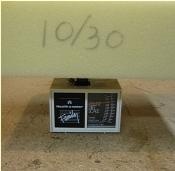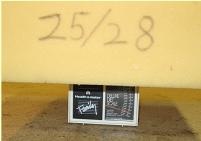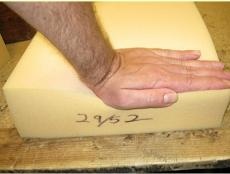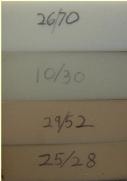Understanding foam:
Eisenberg Upholstery (360) 377-4389
billeisenberg@gmail.com
Eisenberg Upholstery (360) 377-4389
billeisenberg@gmail.com
One of the best ways to make your project look and feel great is knowing about foam.
Pick the wrong foam and your may feel you are sitting on a board or in a bucket. Chose the right foam, and you will add years to you comfort and the life of your furniture.
Pick the wrong foam and your may feel you are sitting on a board or in a bucket. Chose the right foam, and you will add years to you comfort and the life of your furniture.
Easily 25% of all furniture repairs I see deal with bad foam or padding. The point is start with good foam and you won't be sorry.
Although some might not want to be believe this, but foam is one of the easiest things to understand in upholstery.
There are only 2 simple things you should know.
Foam has 2 basic element Density and Firmness.
Density or weight which is the first element and this tell you how much material goes into the foam i.e. the more it weighs the higher the density and the higher the density the higher the weight.
There are only 2 simple things you should know.
Foam has 2 basic element Density and Firmness.
Density or weight which is the first element and this tell you how much material goes into the foam i.e. the more it weighs the higher the density and the higher the density the higher the weight.
The second element tells you the firmness of the foam, which is how much weight it takes to compress the foam 1/3.
That is a 1 cubic foot block of foam will compress 1/3 when a weight equial to it firmness number is placed on the foam.
These elements are expressed in numbers as Density / Firmness.
That is a 1 cubic foot block of foam will compress 1/3 when a weight equial to it firmness number is placed on the foam.
These elements are expressed in numbers as Density / Firmness.
Here is an example of 2 foams 15/15 and 29/52.
Since we know what each set of numbers represents, Density / Firmness (or we can also say Weight / Firmness), we can figure out the destiny and firmness of our foam.
15/30 = 1.5 pounds of foam per cubic foot will take 30 pounds of weight to compress the block of foam 33% or 1/3.
And
29/52 = 2.9 pounds per cubic foot of foam and it will take 52 pounds of weight to compress this block 1/3.
See not so hard as some might lead you to think.
See not so hard as some might lead you to think.
Now what does this mean to you and your furniture?
Here are some simple rules to consider to help guide us:
For seats the thicker the foam the lower compression weight we want.
For seats the thinner the foam the higher the compression weight we
want.
For seats we want a high density foam no less then 2.2
For backs we want a density no higher then 1.8
Make all our foam 1/2 inch bigger all the way around then your cover or pattern i.e. 4 inch boxing = 5 inch foam, 29 inch wide seat = 30 inch foam, 18 inch seat board = 19 inch foam and so on. This way you will have a nice tight seat.
Always rap our foam in bonded dacron or fiber batting.
Here are some simple rules to consider to help guide us:
For seats the thicker the foam the lower compression weight we want.
For seats the thinner the foam the higher the compression weight we
want.
For seats we want a high density foam no less then 2.2
For backs we want a density no higher then 1.8
Make all our foam 1/2 inch bigger all the way around then your cover or pattern i.e. 4 inch boxing = 5 inch foam, 29 inch wide seat = 30 inch foam, 18 inch seat board = 19 inch foam and so on. This way you will have a nice tight seat.
Always rap our foam in bonded dacron or fiber batting.
OK with that said, I'll make it even simpler and let we know what destiny/firmness foam I would consider for my projects using the above information.
Seat foams:
Dining room chairs 1.5 to 3 inch foam 29/52
Chair, Sofa, and love seat 4 to 5 inch foam 25/35,
Chair, Sofa, and love seat 6 to 8 inches go 22/30.
Note: These numbers are industry guides not rules. So there is some variation in numbers like 28/53 instead of 29/52 but basically the same thing. Just a mill change.
Chair, Sofa, and love seat 4 to 5 inch foam 25/35,
Chair, Sofa, and love seat 6 to 8 inches go 22/30.
Note: These numbers are industry guides not rules. So there is some variation in numbers like 28/53 instead of 29/52 but basically the same thing. Just a mill change.
Keep in mind we want the highest density foams you can get for the firmness we chose. In choosing high-density foam we add years to your comfort.
Firm low-density foam may go as little as a few weeks or months until we start to see or feel it losing it's comfort and shape.
Hence most warranties do not cover "foam losing its shape or getting soft."
A Key Take Away:
Foam that is low in weight, although firm, will not last or support as well as a high density softer foam.
example: 25/35 will last years longer, in my real world expernce, then 10/35 for seat foam.
It is literally days or months compared to years or decades.
I upholstered a large set of Dr office waiting room chairs when I was an apprentice. We replaced the cover and the foam with 29/52 2 inch.
Some 15 years later, I reupholstered the same chairs with new fabric but did not need to replace the foam.
15 years later it was still going strong. The Dr office may have saved $800.00 by having us install the right foam for the job.
This knowledge is way we can warrantee quality seat foam for 5 years.
Knowing the numbers of foam density to firmness is the key.
This is what we aren't supposed to understand. Density is the key to foam comfort and life.
Simply put, for seat foam, the higher the density the longer the life.
Hence most warranties do not cover "foam losing its shape or getting soft."
A Key Take Away:
Foam that is low in weight, although firm, will not last or support as well as a high density softer foam.
example: 25/35 will last years longer, in my real world expernce, then 10/35 for seat foam.
It is literally days or months compared to years or decades.
I upholstered a large set of Dr office waiting room chairs when I was an apprentice. We replaced the cover and the foam with 29/52 2 inch.
Some 15 years later, I reupholstered the same chairs with new fabric but did not need to replace the foam.
15 years later it was still going strong. The Dr office may have saved $800.00 by having us install the right foam for the job.
This knowledge is way we can warrantee quality seat foam for 5 years.
Knowing the numbers of foam density to firmness is the key.
This is what we aren't supposed to understand. Density is the key to foam comfort and life.
Simply put, for seat foam, the higher the density the longer the life.
What if we want foam for a back?
Then here is a little guide we can reference.
Back Foam:
Firm back 18/18
Softback 15/15
Then here is a little guide we can reference.
Back Foam:
Firm back 18/18
Softback 15/15
Well that's about it. If you have any other questions about foam or your upholstery project you may call or email me.
Bill
(360) 377-4389
billeisenberg@gmail.com
Eisenberg Upholstery
Bill
(360) 377-4389
billeisenberg@gmail.com
Eisenberg Upholstery
PS The above information will not only help us with our upholstery project, but it will also educate for the next time we have upholstery done or buy a new sofa or chair.
The same rules apply, although the manufacturer may use a different set of numbers. All you need to do is ask which number is for density and which is for firmness.
They may have to make a few phone calls but let them. Know what you are buying.
The same rules apply, although the manufacturer may use a different set of numbers. All you need to do is ask which number is for density and which is for firmness.
They may have to make a few phone calls but let them. Know what you are buying.
This information is offered, copyrighted, and published by Eisenberg Upholstery Bremerton, WA
© 2009 Bill Eisenberg Upholstery




Foam and Dacron Batting


Although you can't tell, I am pushing very hard.

